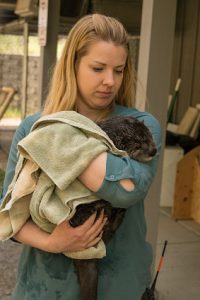 When the otter pup arrived at the Museum, he was a 6-week-old wiggly bundle of energy that tripped over his own feet when he followed after me. When he wasn’t running around and playing with his stash of toys, he was either napping or eating. With neither of us being experienced at bottle feeding, mealtime tended to result in a huge mess.
When the otter pup arrived at the Museum, he was a 6-week-old wiggly bundle of energy that tripped over his own feet when he followed after me. When he wasn’t running around and playing with his stash of toys, he was either napping or eating. With neither of us being experienced at bottle feeding, mealtime tended to result in a huge mess.
Cleaning up after these feedings started out as warm, shallow baths in the sink and a thorough towel drying afterwards to make sure he was warm and dry. As he became comfortable with the sound of the running faucet, the otter pup started sticking his face underwater and blowing bubbles, learning how to close his nose and small ears while in water.
As he grew, so did his love of water, and bath time moved from the sink to a tub. He started using his webbed toes and muscular tail to turn and spin. He went from holding his breath for barely a minute to holding it for three minutes, still a ways off from the nearly six minutes adult river otters can hold their breath.
Though otter pups in the wild are taught to swim by mom around 8 weeks of age, this slower lead up to swimming continued until our pup shed his thinner baby fur and grew in his denser and warmer adult fur around 11 weeks of age. An adult fur coat has 350,000 hairs per square inch and is made up of two layers: guard hairs and under fur. Their outer coat of water repellent guard hair helps prevent the insulating under fur from getting wet, which helps keep their bodies warm while they hunt for aquatic prey such as fish and amphibians all year round.
Since mastering a full bathtub of water, the otter has begun swimming in a large stock tank that allows him to practice swimming, diving, and catching small, live trout with his sharp claws and teeth. He’s also begun exploring the shallows in the museum’s stream habitat where he tosses around pebbles and chases after bugs.
Keep an eye on our Facebook page to follow along as the otter grows!
